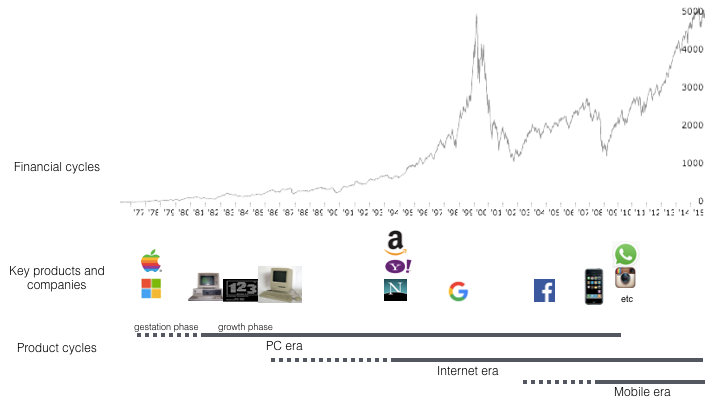Last week's Monday Motivator ("Get Out There and Shake It!") definitely pressed some people’s "personal responsibility" buttons! I heard lots of immediate reactivity, but I also heard from people who decided to take new steps forward by setting up lunch dates, asking someone to read a manuscript, focusing their regular conversation with a colleague on research (instead of departmental gossip, and one person simply decided to approach her cranky colleague in a whole new spirit. Bravo!
The fact of the matter is that most departments aren’t set up to support your success and yet, YOU HAVE TO SUCCEED ANYWAY! So, congratulations to all of you who acknowledged that as your reality and stepped out in a new way last week. And since I'm on the general topic of "Shaking It," let's move on to the next common mistake new faculty members make: Putting All Your Eggs in One Institutional Basket.
I realize that it's incredibly difficult to get a tenure-track job these days, and some of us were in graduate school for so long that we feel extraordinarily grateful to our institutions for simply employing us. In addition, many of us were trained under faculty mentors who spent their entire careers at ONE institution and taught us this was "the way things are" in academic life. Regrettably, the result is that some new faculty members behave as if their very life depends on that tenure decision! They bend over backwards to please everyone at their institution, invest large amounts of time in long term institutional projects, and accept poor treatment from their senior colleagues out of a desperate hope that they will be deemed worthy and allowed to stay. In other words, their identity and self-worth are so wholly dependent on winning tenure at their current institution that failing to do so would be utterly unbearable.
The problem with this approach is two-fold. First and foremost, you don't know whether your current institution is going to make a long-term commitment to you (via tenure and promotion), so why invest 100% of your emotional energy, identity, and self in that outcome? More importantly, this desperate stance puts you in a powerless position because you are, in effect, handing all the power over your future to your employer (instead of assuming some control over it yourself).
How your senior colleagues will vote on your tenure case is out of your control, but there are several important factors that are fully under your control: 1) your research productivity, 2) your emotional investment in your current institution, and 3) promoting your work beyond your institution. Below I outline just a few concrete ways that you can protect yourself from the possibility of future loss, by identifying your power today and using it to invest in yourself first.
Cultivate A Professional Attitude
One of the best ways that you can hedge your bets is to shift your reference group from the faculty at your institution to the broader national arena of your discipline. By understanding yourself as "a scholar who currently works at ______ college/university," you will begin to understand the necessity of not only "shaking it" with your departmental colleagues, but also extending your network to get out there and shake it with the other scholars in your discipline. By proactively extending your network and maximizing your research productivity, you increase the possibility that you will be marketable in your later tenure-track years and then have the ability to decide whether or not you want to stay at your institution (as opposed to whether or not others will allow you to stay).
Make A Top 10 List
The best advice I received as a new faculty member was to make a list of the top 10 people in my research area and then make it my business to connect with them during my five years on the tenure track. Developing your Top 10 list is critical for two reasons: 1) this is the most likely pool of scholars from which your external review letters will be requested when you come up for tenure review; and 2) these are the scholars that your work is in conversation with (a conversation that can't happen if they are unaware of your published work). Even if you are at a college where teaching and research are equally valued, your institution will still solicit external reviews of your scholarship, and they are likely to be drawn from the pool of well-known researchers in your area.
Extend Yourself
Once you have identified your Top 10, figure out how to connect with these individuals. You could invite them to give a talk at your institution, approach them at conferences, send them your recently published article with a personal note, etc. Some will be pleasant and approachable, and others will completely ignore you. What's important is that you begin proactively connecting with people in your discipline who matter to your future success -- as a candidate for tenure and as a scholar. Additionally, feel free to do whatever you think will help introduce other scholars in your field to your work, such as giving talks at your friend's institutions and other local colleges, giving great presentations at conferences, and letting other people know when you have published something they might find useful. The point is to let as many people know about your research as possible while making targeted efforts with those who are likely to be asked to write your external reviews.
If You Are Unhappy, Go On The Market
Nothing puts your current situation in perspective like dipping a toe in the water! If you have published prolifically in the first few years of your current tenure-track job, then you are a far more attractive job candidate than you were ABD, and you are likely to generate more interest than in your previous job search. Sometimes visiting another campus makes you value your current institution in a whole new way, and other times it can make you wonder why on earth you have worked there for so long. Either way, it can be a valuable experience to help you make the mental shift from institutional dependency to independence as a scholar.
Write Every Day
I should have started with this item because everything else I've said is predicated upon your ability to publish your research. Publications are the currency in the academic market so maintaining research productivity will fulfill you as a scholar, increase your marketability, give you some measure of power over your own future, and provide you with the opportunity to make choices. In short, be sure you are writing every day and doing what you need to do to publish your research.
The Weekly Challenge
The fact of the matter is that most departments aren’t set up to support your success and yet, YOU HAVE TO SUCCEED ANYWAY! So, congratulations to all of you who acknowledged that as your reality and stepped out in a new way last week. And since I'm on the general topic of "Shaking It," let's move on to the next common mistake new faculty members make: Putting All Your Eggs in One Institutional Basket.
I realize that it's incredibly difficult to get a tenure-track job these days, and some of us were in graduate school for so long that we feel extraordinarily grateful to our institutions for simply employing us. In addition, many of us were trained under faculty mentors who spent their entire careers at ONE institution and taught us this was "the way things are" in academic life. Regrettably, the result is that some new faculty members behave as if their very life depends on that tenure decision! They bend over backwards to please everyone at their institution, invest large amounts of time in long term institutional projects, and accept poor treatment from their senior colleagues out of a desperate hope that they will be deemed worthy and allowed to stay. In other words, their identity and self-worth are so wholly dependent on winning tenure at their current institution that failing to do so would be utterly unbearable.
The problem with this approach is two-fold. First and foremost, you don't know whether your current institution is going to make a long-term commitment to you (via tenure and promotion), so why invest 100% of your emotional energy, identity, and self in that outcome? More importantly, this desperate stance puts you in a powerless position because you are, in effect, handing all the power over your future to your employer (instead of assuming some control over it yourself).
How your senior colleagues will vote on your tenure case is out of your control, but there are several important factors that are fully under your control: 1) your research productivity, 2) your emotional investment in your current institution, and 3) promoting your work beyond your institution. Below I outline just a few concrete ways that you can protect yourself from the possibility of future loss, by identifying your power today and using it to invest in yourself first.
Cultivate A Professional Attitude
One of the best ways that you can hedge your bets is to shift your reference group from the faculty at your institution to the broader national arena of your discipline. By understanding yourself as "a scholar who currently works at ______ college/university," you will begin to understand the necessity of not only "shaking it" with your departmental colleagues, but also extending your network to get out there and shake it with the other scholars in your discipline. By proactively extending your network and maximizing your research productivity, you increase the possibility that you will be marketable in your later tenure-track years and then have the ability to decide whether or not you want to stay at your institution (as opposed to whether or not others will allow you to stay).
Make A Top 10 List
The best advice I received as a new faculty member was to make a list of the top 10 people in my research area and then make it my business to connect with them during my five years on the tenure track. Developing your Top 10 list is critical for two reasons: 1) this is the most likely pool of scholars from which your external review letters will be requested when you come up for tenure review; and 2) these are the scholars that your work is in conversation with (a conversation that can't happen if they are unaware of your published work). Even if you are at a college where teaching and research are equally valued, your institution will still solicit external reviews of your scholarship, and they are likely to be drawn from the pool of well-known researchers in your area.
Extend Yourself
Once you have identified your Top 10, figure out how to connect with these individuals. You could invite them to give a talk at your institution, approach them at conferences, send them your recently published article with a personal note, etc. Some will be pleasant and approachable, and others will completely ignore you. What's important is that you begin proactively connecting with people in your discipline who matter to your future success -- as a candidate for tenure and as a scholar. Additionally, feel free to do whatever you think will help introduce other scholars in your field to your work, such as giving talks at your friend's institutions and other local colleges, giving great presentations at conferences, and letting other people know when you have published something they might find useful. The point is to let as many people know about your research as possible while making targeted efforts with those who are likely to be asked to write your external reviews.
If You Are Unhappy, Go On The Market
Nothing puts your current situation in perspective like dipping a toe in the water! If you have published prolifically in the first few years of your current tenure-track job, then you are a far more attractive job candidate than you were ABD, and you are likely to generate more interest than in your previous job search. Sometimes visiting another campus makes you value your current institution in a whole new way, and other times it can make you wonder why on earth you have worked there for so long. Either way, it can be a valuable experience to help you make the mental shift from institutional dependency to independence as a scholar.
Write Every Day
I should have started with this item because everything else I've said is predicated upon your ability to publish your research. Publications are the currency in the academic market so maintaining research productivity will fulfill you as a scholar, increase your marketability, give you some measure of power over your own future, and provide you with the opportunity to make choices. In short, be sure you are writing every day and doing what you need to do to publish your research.
The Weekly Challenge
- Write every day for at least 30 minutes.
- Write your Top 10 list (if you don't have one already).
- Consider ways you could connect with the people on your Top 10 list.
- Consider what it would mean to think of yourself FIRST as a scholar, and SECOND as a "junior" faculty member at your particular institution.
- If you feel reactive to imagining yourself beyond your institutional walls, gently and patiently ask yourself WHY?
- If you find yourself feeling "disloyal” by this type of thinking, remind yourself that your institution will quickly and easily cut you loose if you are denied tenure. Then consider how you could adjust your emotional investment in your institution to MATCH its investment in you.








